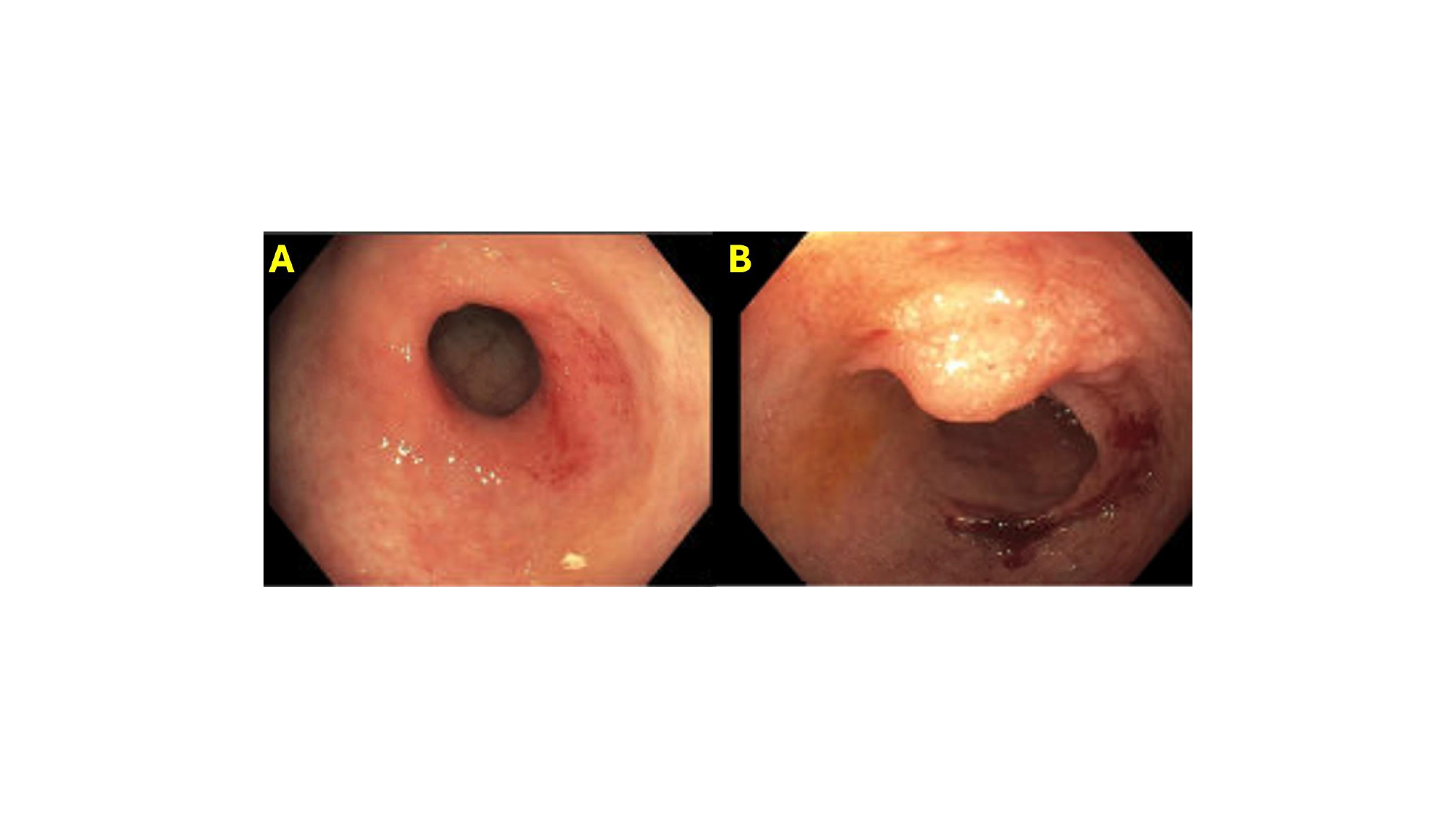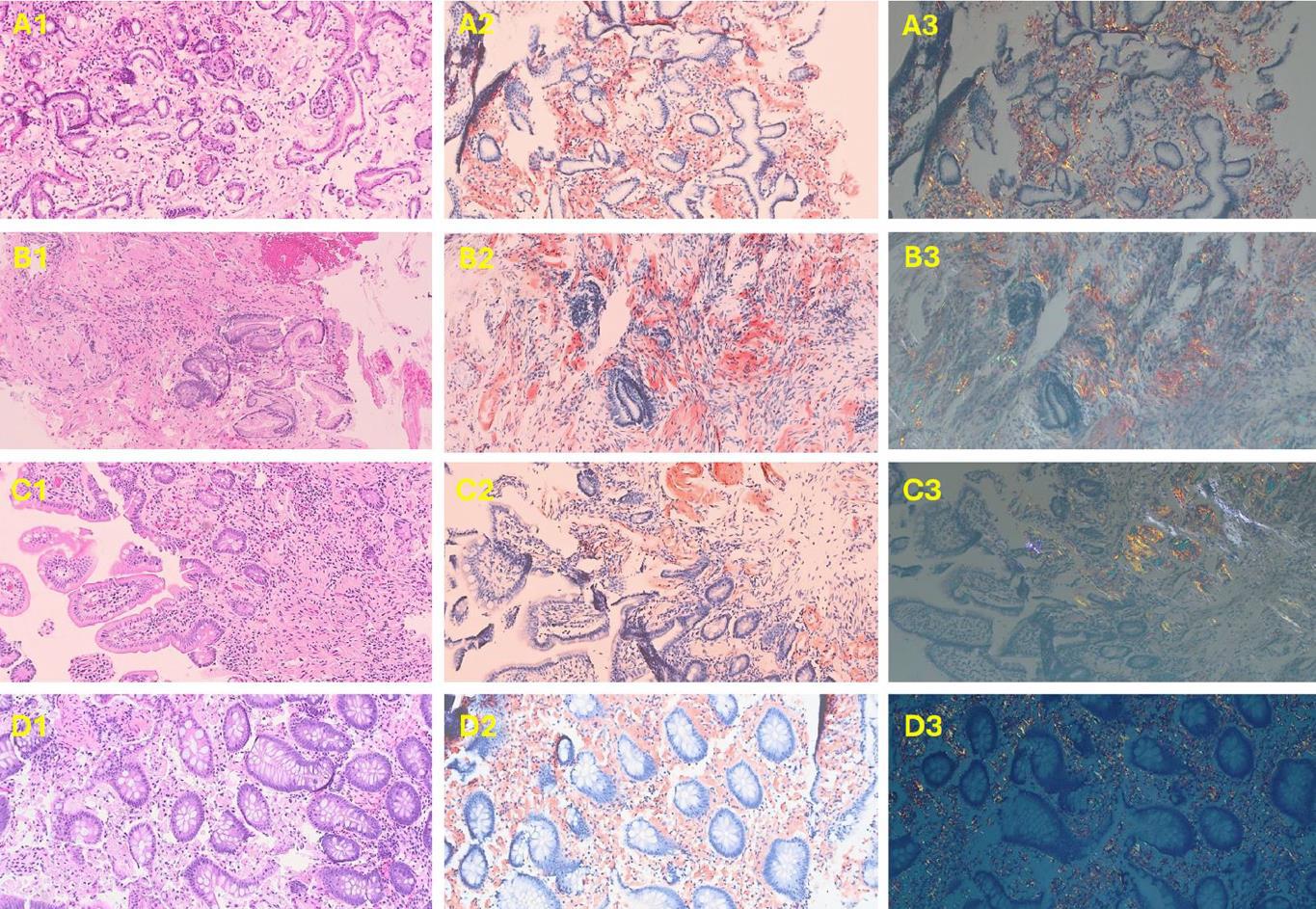Tuesday Poster Session
Category: Small Intestine
P6231 - Beyond the Usual Suspects: Cracking the Case of AA Amyloidosis in the Gut
Tuesday, October 28, 2025
10:30 AM - 4:00 PM PDT
Location: Exhibit Hall

Samuel Cheong, DO
University of Arizona College of Medicine
Tucson, AZ
Presenting Author(s)
Samuel Cheong, DO1, Sabrina Ho, MD2, Brandon Witten, MD2, Shivanand Bomman, MD2, Natasha Khona, DO2, Cameron Thompson, MD2
1University of Arizona College of Medicine, Tucson, AZ; 2Banner - University of Arizona Tucson, Tucson, AZ
Introduction: Amyloidosis refers to a group of disorders characterized by the extracellular deposition of abnormally folded proteins in various tissues. Involvement of the gastrointestinal (GI) tract can lead to a wide range of symptoms. We present a case of chronic diarrhea secondary to gastric amyloidosis.
Case Description/
Methods: A 76-year-old female with a history of Waldenström macroglobulinemia (MYD88 mutation), renal amyloidosis, prior pulmonary embolism (on rivaroxaban), and stage IV marginal zone lymphoma (treated with R-CHOP in 2013), was transferred from a care facility due to hypotension. She reported a 10-month history of chronic diarrhea, characterized by 2–3 episodes daily, which began after a course of amoxicillin. She denied any progression, changes in stool volume, bleeding, weight loss, or abdominal pain. She had tried antidiarrheals with mild improvement in stool consistency but no reduction in frequency. Her last chemotherapy treatment was several months prior to presentation. An EGD and colonoscopy with biopsies had previously been performed, though results were not available.
During hospitalization, laboratory evaluation revealed elevated fecal calprotectin, gastrin, and 5-HIAA levels. Infectious workup was negative. A small bowel push enteroscopy demonstrated gastric mucosal atrophy, gastritis, multiple gastric and duodenal polyps, and erythematous duodenopathy. Biopsies revealed amyloid deposition extending from the stomach to the jejunum. Colonoscopy showed friable mucosa with spontaneous bleeding and three polyps (5–10 mm, including a tubular adenoma and a tubulovillous adenoma). Colon biopsies also confirmed amyloid deposition, later identified as type AA amyloid protein.
Discussion: Gastrointestinal involvement in systemic amyloidosis is rare, reported in approximately 3% of cases. Amyloidosis subtypes include primary (AL amyloidosis, associated with monoclonal light chains and plasma cell dyscrasias) and secondary (AA amyloidosis, related to serum amyloid A protein and chronic inflammatory conditions). In this case, biopsy results were consistent with AA amyloidosis, which typically deposits in the propria mucosae, leading to mucosal friability, erosions, vascular proliferation, and clinical manifestations such as diarrhea and malabsorption. Management of GI amyloidosis is primarily supportive, focusing on symptom control and treatment of the underlying condition. This case highlights amyloidosis as an important differential for chronic diarrhea.

Figure: Figure 1. A. EGD demonstrating inflammation of the second portion of the duodenum. B. Duodenal polyp.

Figure: Figure 2: A1, B1, C1, D1. H&E biopsy of stomach, duodenum, jejunum, and colon with intervening amorphous and eosinophilic material, respectively. A2, B2, C2, D2. Amorphous material is salmon-red on a Congo Red stain positive for Amyloidosis in stomach, duodenum, jejunum, and colon, respectively. A3, B3, C3, D3. When Congo Red stain is polarized, the amorphous material demonstrates apple green birefringence consistent with Amyloidosis in stomach, duodenum, jejunum, and colon, respectively.
Disclosures:
Samuel Cheong indicated no relevant financial relationships.
Sabrina Ho indicated no relevant financial relationships.
Brandon Witten indicated no relevant financial relationships.
Shivanand Bomman indicated no relevant financial relationships.
Natasha Khona indicated no relevant financial relationships.
Cameron Thompson indicated no relevant financial relationships.
Samuel Cheong, DO1, Sabrina Ho, MD2, Brandon Witten, MD2, Shivanand Bomman, MD2, Natasha Khona, DO2, Cameron Thompson, MD2. P6231 - Beyond the Usual Suspects: Cracking the Case of AA Amyloidosis in the Gut, ACG 2025 Annual Scientific Meeting Abstracts. Phoenix, AZ: American College of Gastroenterology.
1University of Arizona College of Medicine, Tucson, AZ; 2Banner - University of Arizona Tucson, Tucson, AZ
Introduction: Amyloidosis refers to a group of disorders characterized by the extracellular deposition of abnormally folded proteins in various tissues. Involvement of the gastrointestinal (GI) tract can lead to a wide range of symptoms. We present a case of chronic diarrhea secondary to gastric amyloidosis.
Case Description/
Methods: A 76-year-old female with a history of Waldenström macroglobulinemia (MYD88 mutation), renal amyloidosis, prior pulmonary embolism (on rivaroxaban), and stage IV marginal zone lymphoma (treated with R-CHOP in 2013), was transferred from a care facility due to hypotension. She reported a 10-month history of chronic diarrhea, characterized by 2–3 episodes daily, which began after a course of amoxicillin. She denied any progression, changes in stool volume, bleeding, weight loss, or abdominal pain. She had tried antidiarrheals with mild improvement in stool consistency but no reduction in frequency. Her last chemotherapy treatment was several months prior to presentation. An EGD and colonoscopy with biopsies had previously been performed, though results were not available.
During hospitalization, laboratory evaluation revealed elevated fecal calprotectin, gastrin, and 5-HIAA levels. Infectious workup was negative. A small bowel push enteroscopy demonstrated gastric mucosal atrophy, gastritis, multiple gastric and duodenal polyps, and erythematous duodenopathy. Biopsies revealed amyloid deposition extending from the stomach to the jejunum. Colonoscopy showed friable mucosa with spontaneous bleeding and three polyps (5–10 mm, including a tubular adenoma and a tubulovillous adenoma). Colon biopsies also confirmed amyloid deposition, later identified as type AA amyloid protein.
Discussion: Gastrointestinal involvement in systemic amyloidosis is rare, reported in approximately 3% of cases. Amyloidosis subtypes include primary (AL amyloidosis, associated with monoclonal light chains and plasma cell dyscrasias) and secondary (AA amyloidosis, related to serum amyloid A protein and chronic inflammatory conditions). In this case, biopsy results were consistent with AA amyloidosis, which typically deposits in the propria mucosae, leading to mucosal friability, erosions, vascular proliferation, and clinical manifestations such as diarrhea and malabsorption. Management of GI amyloidosis is primarily supportive, focusing on symptom control and treatment of the underlying condition. This case highlights amyloidosis as an important differential for chronic diarrhea.

Figure: Figure 1. A. EGD demonstrating inflammation of the second portion of the duodenum. B. Duodenal polyp.

Figure: Figure 2: A1, B1, C1, D1. H&E biopsy of stomach, duodenum, jejunum, and colon with intervening amorphous and eosinophilic material, respectively. A2, B2, C2, D2. Amorphous material is salmon-red on a Congo Red stain positive for Amyloidosis in stomach, duodenum, jejunum, and colon, respectively. A3, B3, C3, D3. When Congo Red stain is polarized, the amorphous material demonstrates apple green birefringence consistent with Amyloidosis in stomach, duodenum, jejunum, and colon, respectively.
Disclosures:
Samuel Cheong indicated no relevant financial relationships.
Sabrina Ho indicated no relevant financial relationships.
Brandon Witten indicated no relevant financial relationships.
Shivanand Bomman indicated no relevant financial relationships.
Natasha Khona indicated no relevant financial relationships.
Cameron Thompson indicated no relevant financial relationships.
Samuel Cheong, DO1, Sabrina Ho, MD2, Brandon Witten, MD2, Shivanand Bomman, MD2, Natasha Khona, DO2, Cameron Thompson, MD2. P6231 - Beyond the Usual Suspects: Cracking the Case of AA Amyloidosis in the Gut, ACG 2025 Annual Scientific Meeting Abstracts. Phoenix, AZ: American College of Gastroenterology.
